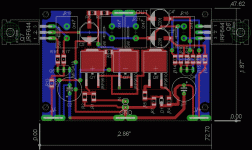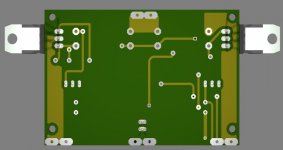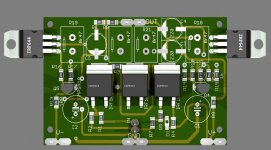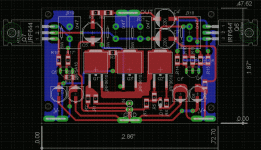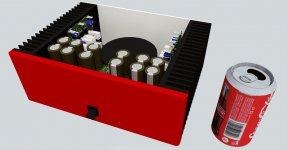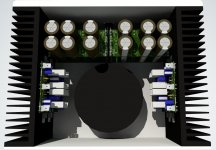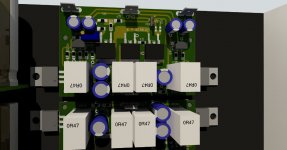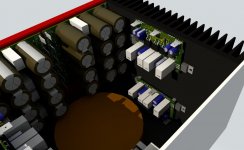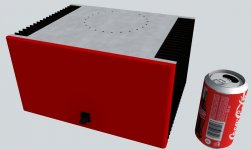thanks Zen, but I think he just uses a potential divider, ie two resistors to reduce input level? So can I just do that, say 10k in series with 100k and take the input from across the 10K resistor?
Do you think this would sound better than lowering gain?
Do you think this would sound better than lowering gain?
just say that I wouldn't change Aleph's gain for more than 6db
if needed - waste rest of signal in attenuator
if needed - waste rest of signal in attenuator
Member
Joined 2002
Ok, small enough now?
not bad, i can see some stuff to move and re-arrange.
Member
Joined 2002
Digit's
highlighted some un needed traces that you could combine and stuff.
Have a look..
An externally hosted image should be here but it was not working when we last tested it.
highlighted some un needed traces that you could combine and stuff.
Have a look..
Thanks Zen, I will use attenuator and see how it works. So if I use the aleph J as an example, and use 110k as the attenuator, then my input impeadance will now be 75K. This seems like a pretty easy load for a source, does anything else change?
Erm, yeah, I see what you did, but its a little diffirent from the way I like to do things. You would tie the path to groundstar together for C5 and R2, I probably wouldn't.
As for the connection of the 3 front FET's, I realy don't like running traces in the top layer through that gap, had a few mishaps with those, I did however modify it slightly along your suggested path.
Also you will see now why some of the traces were the way they were with the next set of bypass caps in.
As for the connection of the 3 front FET's, I realy don't like running traces in the top layer through that gap, had a few mishaps with those, I did however modify it slightly along your suggested path.
Also you will see now why some of the traces were the way they were with the next set of bypass caps in.
Attachments
Last edited:
Ho Ho Ho!, things are starting to take shape, but I hit a few detours before I decided on a (for now) final implementation. I might have mentioned before that I want an active bi-amped setup...at basement prices. This meant a few compromises would have to be made, but mostly in the form of some aspects that were desigened over the top, are now more marginal.
4 small heatsinks costs more than 2 big ones, one large transformer costs less than 2 or 4 small ones (I left space to add another transformer in the future though, like my current system has). Originaly I was going for 160VA or two 80VA's settled for 225VA, which is the largest I can get here, larger might still fit. Heatsinks went from four 1.1C/W units to two 0.6C/W ones, augmented by solid aluminium face and back. So, with 60W dissipation on each ther should be maybe a bit over 30C rise in temps.
I never have big cash, so it had to be a modular design, allowing me to add channels and power supplies over time, while still haveing a functional unit.
So the final result is the Micro Aleph (BTW, which aleph is the Mini a mini of?)
This little baby in 4 litres of internal volume packs;
180000uF capacitor bank, in 4 seperate power supplies.
4 channels of Mini Aleph in biamp configuration will push out the equivalent of 40W per chanel.
225VA transformer.
And the whole deal fits into 11"x8.5"x4"
4 small heatsinks costs more than 2 big ones, one large transformer costs less than 2 or 4 small ones (I left space to add another transformer in the future though, like my current system has). Originaly I was going for 160VA or two 80VA's settled for 225VA, which is the largest I can get here, larger might still fit. Heatsinks went from four 1.1C/W units to two 0.6C/W ones, augmented by solid aluminium face and back. So, with 60W dissipation on each ther should be maybe a bit over 30C rise in temps.
I never have big cash, so it had to be a modular design, allowing me to add channels and power supplies over time, while still haveing a functional unit.
So the final result is the Micro Aleph (BTW, which aleph is the Mini a mini of?)
This little baby in 4 litres of internal volume packs;
180000uF capacitor bank, in 4 seperate power supplies.
4 channels of Mini Aleph in biamp configuration will push out the equivalent of 40W per chanel.
225VA transformer.
And the whole deal fits into 11"x8.5"x4"
Attachments
Last edited:
MiniA is mini of Aleph30. So you have a AlephLargey.
I dont find issue with your layout. Seems very compact for the number of components on it. Case looks great.
I have reservations about 40W and only 30C rise though. You are looking at .6*60 dissipation which is much more than only 30C and nothing is ever as efficient as the specs. Plus you probably did not consider perfect placement for even thermal dissipation into the sinks when you placed your mosfets on the board. The way I see it right now they will get much hotter than 30 or even 40C above ambient. A small fan on either side will take care of this problem though if you change nothing. If you run thermal simulations I think you will find a huge amount of heat near those mosfets. I am sure it will still work and sound wonderful but dissipating 60W is not going to happen without some serious heating way past the temp you seem to be expecting.
Uriah
I dont find issue with your layout. Seems very compact for the number of components on it. Case looks great.
I have reservations about 40W and only 30C rise though. You are looking at .6*60 dissipation which is much more than only 30C and nothing is ever as efficient as the specs. Plus you probably did not consider perfect placement for even thermal dissipation into the sinks when you placed your mosfets on the board. The way I see it right now they will get much hotter than 30 or even 40C above ambient. A small fan on either side will take care of this problem though if you change nothing. If you run thermal simulations I think you will find a huge amount of heat near those mosfets. I am sure it will still work and sound wonderful but dissipating 60W is not going to happen without some serious heating way past the temp you seem to be expecting.
Uriah
Yeah, its a real bummer, I wish I can find the same heatsink in 250mm long version, I could move the boards to the front, but am afraid of putting the output fets so close to the power caps, it will drasticaly bake them I guess. I don't realy want to go over 4U height point, it just starts to look fugly after a while.
If it helps any the one set of amps will drive a 16 ohm driver without crossover and the other set is for tweeters crossed over at about 5kHz, so should not have too hard a life. What do you think. Can it work?
Capacitors chosen for the amp boards are Rubycons rated for 7000hrs at 105C.
I've never been able to sufficiently isolate a fan's noise from the rest of an amp.
Toying with the addition of 120mm fan under the case lid pushing hot air up. But it wont be needed for the next 6 months, its winter now, any heat is appreciated.
I guess I can subtract a few comma points for the face and rear too in dissipation, there is 4x 400 square mm of contact between sinks and panels.
If it helps any the one set of amps will drive a 16 ohm driver without crossover and the other set is for tweeters crossed over at about 5kHz, so should not have too hard a life. What do you think. Can it work?
Capacitors chosen for the amp boards are Rubycons rated for 7000hrs at 105C.
I've never been able to sufficiently isolate a fan's noise from the rest of an amp.
Toying with the addition of 120mm fan under the case lid pushing hot air up. But it wont be needed for the next 6 months, its winter now, any heat is appreciated.
I guess I can subtract a few comma points for the face and rear too in dissipation, there is 4x 400 square mm of contact between sinks and panels.
Last edited:
So why do you want to output so much heat if you dont need all the power? The MiniA is giving you 8W which is a lot for your tweeters, most likely fine for your 16R driver which I am guessing is uber efficient although you need some voltage to drive 16R. I think you need to start with real low bias and consider a copper heat spreader but make real sure you get great contact with copper on both sides or its worthless. With your restrictions on mosfet placement and heatsink size you dont have the luxury of high bias even if your caps can handle it. You could call it your Great Ball of Fire.
Uriah
Uriah
There are a few ways to get small computer fans quiet. Even Nelson says they are not evil. Run them on low voltage with a cap across their power inputs. If it says its a 12V fan, run it at 5V. You barely need any air movement but a tiny bit will make a huge difference.
So why do you want to output so much heat if you dont need all the power? The MiniA is giving you 8W which is a lot for your tweeters, most likely fine for your 16R driver which I am guessing is uber efficient although you need some voltage to drive 16R. I think you need to start with real low bias and consider a copper heat spreader but make real sure you get great contact with copper on both sides or its worthless. With your restrictions on mosfet placement and heatsink size you dont have the luxury of high bias even if your caps can handle it. You could call it your Great Ball of Fire.
Uriah
Erm I am not wanting any more power than the standard implimentation, just seperates for biamping. I'll sleep on the larger sinks cases, I am just not sure I could make one look pretty. Also I have very little space for an 8" heigh case to live neatly. I guess some kind of cork base would be nice to shield whatever lives under the amp.
P.S. I realy appreciate your input though, your good sense may just win me over before I start placeing orders for materials.
PSS, I just found a 6" version of the same sink, wich is 0.48C/W, which I think stands for 0.48cent per wallet (which is what I'll have left)
Last edited:

There are also these guys that go for about $50 a pop with 2W 12V fans rated at 0.16C/W, but no rateing on the fan noise, which I assume to be quite high at full tilt.
I think Zen Mod's idea will work well for you. You would make it so that there is an inch or so of room beneath, the fan spits air upward and design the base of his device so that the air flows to left and right and then up/through your sinks. Carpet an inch or two beneath it and amp on top of it, I doubt you could hear the fan at all.
Those you have a pic of will be loud but otoh you might not need them turned up very fast/high. I like your design of your amp. With a bit of airflow it will work great.
Uriah
Those you have a pic of will be loud but otoh you might not need them turned up very fast/high. I like your design of your amp. With a bit of airflow it will work great.
Uriah
Member
Joined 2002
looking good, you do know that your heat sinks fins are in the perfect direction, allowing air to move through them, my mini a's are on 12" x 5" and 3/4" fins and are going the opposite way and stay cool so, i think you will be fine, however if not you could always do what zen suggested, a nice 6" computer fan running at 5V would be so perfect.
Thanks for the encouragement, I think I will take the time and render a 6U unit before I get all set on the idea of a HAWT ALEPH, btw, ist the 30 balanced? and the 3 unbalanced like the mini?
... damn I was gonna be all clever and call it the Aleph 4, because of the internal volume, not the number of channels 😀
would the 0.48C sink be big enough to upgrade to some of the bigger alephs in future?
... damn I was gonna be all clever and call it the Aleph 4, because of the internal volume, not the number of channels 😀
would the 0.48C sink be big enough to upgrade to some of the bigger alephs in future?
Last edited:
OK, here is a stab at what it would look like with those sinks, I bet with the face and rear we can at least say it is 0.4C/W. The larger face allows me to move the PSU's forward and rotate them, which in turn allows the PCBs of the amps to be placed dead centre and the actual transistors at 25 and 75% of height (so nealy the centre of every quarter).
It honestly is a better design, I just like the slim look better, why is it so hard sometimes to choose between right and pretty?
It honestly is a better design, I just like the slim look better, why is it so hard sometimes to choose between right and pretty?
Attachments
- Home
- Amplifiers
- Pass Labs
- The Mini-A
